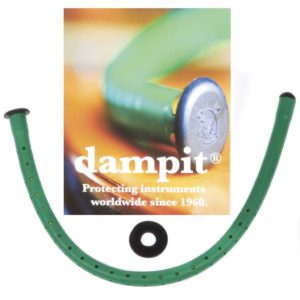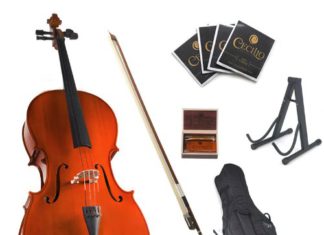Are you a regular traveling musician or keep your cello in a dry place? If so, you’ll want to invest in a dampit. Harsh winter weather and dry environments can cause severe damage to your cello in the form of cracks. A single crack on your fine cello not only reduces the sound quality but is also detrimental to your equipment. You never want to open your case and see a crack running down your instrument. One proven way of preventing damage to your instrument is to use a cello dampit. You can read more about the dampits and humidifiers that we recommend in our review of the best cello dampits and humidifiers.
What is a Cello Dampit?
A cello dampit is a device that is specially designed to release humidity inside of your cello instrument. A cello dampit is scientifically tested and proven to provide maximum protection to your instrument against damage due to hot, dry and freezing weather. Dampit humidifiers have served thousands of classical cellists for several years to protect their acoustic instruments. A dampit is made of low-cost materials that render it both efficient and economical in maintaining proper humidity levels under dry conditions. It prevents cracks and restores moisture to the wood in your cello.
The dampit itself is a soft rubber sleeve that houses a special open-cell sponge which releases water slowly to ensure your instrument is properly humidified. With proper care, your cello humidifier can last for several years without needing frequent replacement.
Dampits also come with handy humidity indicators that help you to maintain the optimal humidity for your cello. Maintaining proper humidity will make your cello sound its best for years to come.
Why Do You Need a Dampit?
As a cellist, you never want to perform on stage with that screechy cello. It not only kills your motive but can scare away your audience. A good sounding instrument is paramount to your overall music profile. A dampit ensures that your instrument never dries out or produces a strange and poor quality sound. Compared to other humidifiers, a dampit is both efficient and economical. Other humidifier brands tend to humidify the lining of the cello case rather than the cello itself. This is why a cello dampit is the most trusted musician companion. In fact, it is frequently recommended by professional musicians and teachers to beginner cellists so that they start off maintaining their cellos properly.
Inside of the dampit is a quality and durable sponge that holds moisture for a long time. They are also very easy to use. When filled and placed inside of a cello, the water evaporates from the sponge, ensuring that the cello retains moisture and does not dry out. When the dampit is dry, all you need to do is to soak it for a few minutes in water. You can then squeeze it to remove excess water, and it will be ready for use. Dampits are available in various sizes. You can choose the right size that matches your equipment.
A dampit is inexpensive compared to the overall value of your instrument, but will save you hundreds or thousands of dollars in costly instrument repairs when used properly. It is unimaginable to have your instrument damaged due to a problem that is preventable. Regardless of whether you are playing a cheap or high-end cello, we recommend that you buy a dampit to humidify and prevent your instrument from cracking and warping.
Dampits have been scientifically tested and proven to be efficient humidifying musical instruments. Due to their unmatched reliability, dampits have been used for more than 40 years by musicians from all over the world. Instrumentalists from all over the world rely on dampits in protecting their precious instruments. Besides, it is very durable and can last longer than any other instrument humidifying device.
How to Use a Cello Dampit Humidifier
A cello dampit is easy to use. In fact, you don’t need any training to use it. Just follow simple instructions, and you’ll be good to go. Just perform the following steps to get started with your dampit.
- Immerse your dampit in distilled water and leave it for about 30 seconds
- Pinch one end of your dampit to remove excess water. When it is moderately damp, wipe the outer tube with a dry cloth.
- Insert the dampit inside your cello through the F-hole.
- Use the dampit humidity level indicator (included in the package) to check the percentage of the humidity in your room or area. Remember that as humidity changes from time to time and place to place, the numbers on the indicator change responsively. In the case of pink segments, then it means the humidity is above 50%. Optimum humidity often ranges from 45% to 55%. It is good to take the readings on your indicator more often to avoid damaging your valuable instrument.
- Ensure that the dampit remains inside your cello while it’s in the case. You may take it out while playing for brief periods so that your cello doesn’t have odd vibrations, but make sure that you put it back in immediately when you are done playing.
- We recommend that you store your cello in a cool place. Keep it away from radiators. Do not expose your instrument to heaters. This way, your cello will retain moisture longer.
- Use your dampit during cold and dry weather conditions only, generally only during the winter months when the heat is on. It is advisable to avoid over-humidifying or under-humidifying your instrument. However, the good thing with dampits is that they are sensitive to changes in humidity levels.
Conclusion
If you want to keep your cello for a long time, you should invest in a dampit. They are generally less than $20, but will save you hundreds or thousands of dollars in costly repairs. There is no perceptible loss of sound quality when you are using a cello dampit humidifier and it is a savior during the harsh winter months. You should definitely get a dampit if you don’t want to expose your instrument to cracks caused by dryness. Buy a cello dampit today and protect your instrument from sound loss and damages.
Table of Contents












